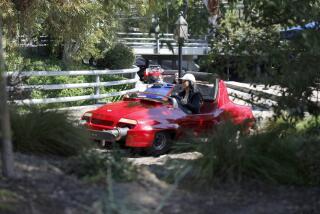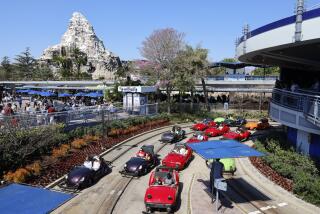A real roadster in its blood
THE Saturn Sky — the celestially seasoned version of the Pontiac Solstice roadster — reminds us that there is no idea so good that GM won’t toss it in a burlap sack and beat it with reeds. Such a notion was the Saturn Corp. Set up in the pastoral Podunk of Spring Hill, Tenn., in the late 1980s, Saturn was supposed to be anodyne to all things wrong with Detroit. At a time when GM’s other divisions shared more DNA than the Habsburgs, Saturn was a fresh-slate approach to car-building, with its own cars, reflecting its own engineering and design philosophy. It had its own customer-focused, no-haggle retail environment, inviting you to join the “Saturn family,” with all the podpeople overtones the phrases implies.
Saturn was all that, for about five minutes. Then the company began its slow spiral into GM’s corporate gravity well. No vehicle better exemplifies Saturn’s rescinded autonomy than the Relay minivan, a re-badged version of the Chevy Uplander/Pontiac SV6/Buick Terraza. That’s so GM orthodox it’s practically Hasidic.
But now, with the release of the Saturn Sky, GM is unveiling a new orbital path for the Ringed Planet. Forget independence and second-channel thinking. Henceforth, the Saturn brand will stand for a better class of product redundancy.
Compared to its clonal sibling the Pontiac Solstice, the Saturn Sky is more likable in every direction. The Sky’s exterior styling, with the Corvette-like saber scars on its cheeks, the beveled, refractory chrome accents all around and other visual wickedness, has a honed and hardened raciness the slightly edemic Solstice doesn’t. It’s no coincidence that the Sky’s styling is reminiscent of the old Opel Speedster, since the Sky — styled in GM’s Coventry, England, studio — will be sold overseas as the Opel GT.
Likewise, the Sky’s interior looks and feels more polished and sophisticated, with gloss-black surfacing on the central console (“piano” black, if you make your pianos from molded plastic resin) and e-brake lever, and brushed alloy trim on the shift console and door handles. The upgrading extends to the standard equipment list, with the Sky offering air-conditioning, projector head lamps, anti-lock brakes, cruise control, power accessories, keyless entry and lots of other cost-extra items on the Solstice’s order list. The Sky costs about three grand more than the base Solstice and weighs 73 pounds more. Both penny and pound penalties seem worth it.
Most perplexing — especially if you’re a Pontiac dealer — is that the Sky drives better. This might have to do with the extra months of experience gained by the staff at the Wilmington, Del., factory, where Solstice and Sky are assembled. The Sky feels more of a piece than the early production Solstice I drove, which had a modest hood shake and various titters and squeaks. The Sky — also built on the rear-drive Kappa platform, with an architecture of hydroformed steel frame rails, à la Corvette — feels by degrees stiffer in the backbone and slightly more limber at the wheels. The Sky’s Bilstein coil-overs have a touch more compliance dialed into them. With longer suspension travel and less rigid anti-roll bars, the Sky serves up a more comfortable, less concussive ride and stays planted on rough pavement that would make the Solstice skip like a phonograph needle.
Solstice and Sky are powered by the same 2.4-liter twin-cam four engine routing max power of 177 hp through a nick-nick, five-speed gearbox (an automatic is optional). The Sky can light the rear tires up in first gear, but it isn’t really a hard-punching sports car. Zero-to-60 mph acceleration is about 7.5 seconds. The car is at its best on mountain snares and carousels, where you can keep the engine roiling at around 4,000 rpm, wrist-shifting between second and third gears. The engine’s thrusty character and the syrupy burbles in the exhaust note remind me of a good British roadster. My MGA, for instance.
For a little corporate cupcake, the Sky is capable of some significant hard driving. The steering is sharp, taut and full of subtle feedbacks from the asphalt. The cornering grip — thanks mainly to the big Goodyears on the corners — is reliable and easy to access. With its slightly nose-heavy weight distribution, the Sky can be coaxed into nice, progressive tail-sliding behavior that can be nulled out with a dab of throttle and counter steer.
Once on the highway, shift the car into fifth gear and the Sky drops an octave. The Sky-walker is a comfortable cruiser, with well bolstered seats, a decent sound system and adequate protection from buffeting at speeds up to about 80 mph. The steering has good self-centering behavior at high speed but the Sky never loses that alert, slightly darty feel of a roadster. Meanwhile, few cars at any price cut such a compellingly shaped hole in the wind.
Of course, there are small irritations. For a car named Sky, the sky is actually quite hard to access. The top requires several awkward steps to open and close, and one step where you have to jump on the rear hatch like a crazy person to make sure it’s closed.
Quibbling aside, the Saturn Sky is an immensely likable car with a cool factor measured in parsecs. After Corvette, this is my favorite car from the General, and I would recommend it to anyone.
So it might seem a rude question: Why is this car a Saturn? Why does this brand need a hot roadster that actually out-Solstices the Pontiac? Even more impertinent: Why will Saturn get the Sky Red Line, a version of the Pontiac Solstice GXP, the turbocharged, 260-hp piece of road ordnance? And while I’m asking, I’d be interested in hearing the corporate strategy behind the Saturn Aura. This is a handsome variant of the Pontiac G6, only equipped with bigger engines, a trick new six-speed manumatic transmission (optional), and higher levels of trim. Cannibalism, anyone?
In very short order, Saturn has gone from the redheaded hillbilly stepchild of GM’s brand lineup to something of a favored son. GM will even be bringing swank, Euro-style Opels to the States and putting the little red badges on them. If this keeps up, Saturn will be GM’s most interesting and innovative brand, and its coolest. It will have traveled across the universe to wind up in the place it started.
*
Contact automotive critic Dan Neil at dan.neil@latimes.com.
*2007 Saturn Sky
Base price: $23,690, including $575 delivery
Price, as tested: $26,150
Powertrain: 2.4-liter, 16-valve, DOHC inline four cylinder with variable valve timing; five-speed manual transmission; rear-wheel drive
Horsepower: 177 at 6,600 rpm
Torque: 166 pound-feet at 4,800 rpm
Curb weight: 2,933 pounds
0-60 mph: 7.5 seconds
Wheelbase: 95.1 inches
Overall length: 161.1 inches
EPA fuel economy: 20 miles per gallon city, 28 mpg highway
Final thoughts: Aiming at Miata, Saturn hits Solstice






